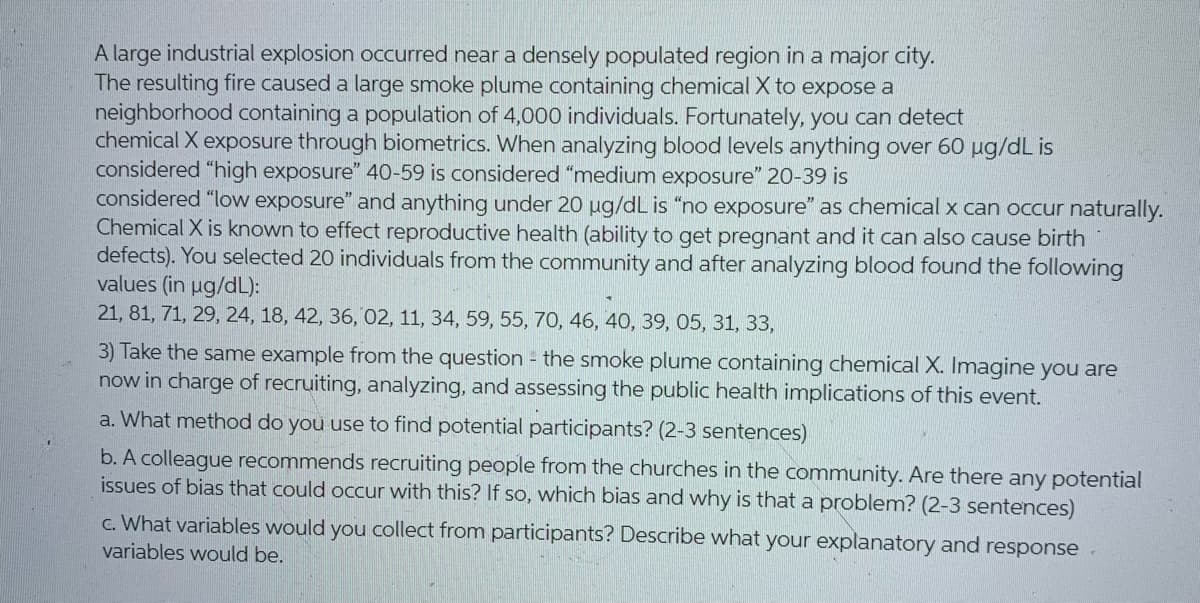A large industrial explosion occurred near a densely populated region in a major city. The resulting fire caused a large smoke plume containing chemical X to expose a neighborhood containing a population of 4,000 individuals. Fortunately, you can detect chemical X exposure through biometrics. When analyzing blood levels anything over 60 ug/dL is considered "high exposure" 40-59 is considered "medium exposure" 20-39 is considered "low exposure" and anything under 20 ug/dL is "no exposure" as chemical x can occur naturally. Chemical X is known to effect reproductive health (ability to get pregnant and it can also cause birth defects). You selected 20 individuals from the community and after analyzing blood found the following values (in ug/dL): 21, 81, 71, 29, 24, 18, 42, 36, 02, 11, 34, 59, 55, 70, 46, 40, 39, 05, 31, 33, 3) Take the same example from the question - the smoke plume containing chemical X. Imagine you are now in charge of recruiting, analyzing, and assessing the public health implications of this event. a. What method do you use to find potential participants? (2-3 sentences) b. A colleague recommends recruiting people from the churches in the community. Are there any potential issues of bias that could occur with this? If so, which bias and why is that a problem? (2-3 sentences) c. What variables would you collect from participants? Describe what your explanatory and response variables would be.
A large industrial explosion occurred near a densely populated region in a major city. The resulting fire caused a large smoke plume containing chemical X to expose a neighborhood containing a population of 4,000 individuals. Fortunately, you can detect chemical X exposure through biometrics. When analyzing blood levels anything over 60 ug/dL is considered "high exposure" 40-59 is considered "medium exposure" 20-39 is considered "low exposure" and anything under 20 ug/dL is "no exposure" as chemical x can occur naturally. Chemical X is known to effect reproductive health (ability to get pregnant and it can also cause birth defects). You selected 20 individuals from the community and after analyzing blood found the following values (in ug/dL): 21, 81, 71, 29, 24, 18, 42, 36, 02, 11, 34, 59, 55, 70, 46, 40, 39, 05, 31, 33, 3) Take the same example from the question - the smoke plume containing chemical X. Imagine you are now in charge of recruiting, analyzing, and assessing the public health implications of this event. a. What method do you use to find potential participants? (2-3 sentences) b. A colleague recommends recruiting people from the churches in the community. Are there any potential issues of bias that could occur with this? If so, which bias and why is that a problem? (2-3 sentences) c. What variables would you collect from participants? Describe what your explanatory and response variables would be.
Glencoe Algebra 1, Student Edition, 9780079039897, 0079039898, 2018
18th Edition
ISBN:9780079039897
Author:Carter
Publisher:Carter
Chapter4: Equations Of Linear Functions
Section4.5: Correlation And Causation
Problem 2AGP
Related questions
Question
Please answer part a-c.

Transcribed Image Text:A large industrial explosion occurred near a densely populated region in a major city.
The resulting fire caused a large smoke plume containing chemical X to expose a
neighborhood containing a population of 4,000 individuals. Fortunately, you can detect
chemical X exposure through biometrics. When analyzing blood levels anything over 60 µg/dL is
considered "high exposure" 40-59 is considered "medium exposure" 20-39 is
considered "low exposure" and anything under 20 ug/dL is "no exposure" as chemical x can occur naturally.
Chemical X is known to effect reproductive health (ability to get pregnant and it can also cause birth
defects). You selected 20 individuals from the community and after analyzing blood found the following
values (in ug/dL):
21, 81, 71, 29, 24, 18, 42, 36, 02, 11, 34, 59, 55, 70, 46, 40, 39, 05, 31, 33,
3) Take the same example from the question the smoke plume containing chemical X. Imagine you are
now in charge of recruiting, analyzing, and assessing the public health implications of this event.
a. What method do you use to find potential participants? (2-3 sentences)
b. A colleague recommends recruiting people from the churches in the community. Are there any potential
issues of bias that could occur with this? If so, which bias and why is that a problem? (2-3 sentences)
c. What variables would you collect from participants? Describe what your explanatory and response.
variables would be.
Expert Solution
Step 1
It is given that after a fire accident, to test the level of chemical X in surrounding people, a sample of size 20 is selected and the level of chemical X in there blood is recorded.
Step by step
Solved in 2 steps

Recommended textbooks for you

Glencoe Algebra 1, Student Edition, 9780079039897…
Algebra
ISBN:
9780079039897
Author:
Carter
Publisher:
McGraw Hill

Glencoe Algebra 1, Student Edition, 9780079039897…
Algebra
ISBN:
9780079039897
Author:
Carter
Publisher:
McGraw Hill